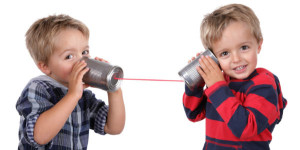Common Delays
Some of the typical signs or symptoms of a speech/language delay or disorder for children under 5 years old:
- › Does not seem to respond or recognize own name
- › Difficulty engaging in eye contact during interaction
- › Little interest in interacting with familiar people
- › Does not follow adults pointing at objects of interest
- › Difficulty producing speech sounds
- › Poor speech clarity even to familiar adults (by 4 years)
- › Rather point or gesture than use words
- › Frequent babbling without true intent to communicate
- › Can repeat words but unable to interdentally label familiar people or verbally request things.
- › Frequent temper tantrums due to difficulty expressing his or her needs or being understood
- › Stutters or “searching for words”
- › Have difficulty formulating short phrases (after 2 years) and difficulty with sentences (after 3 years).
Why do some children have difficulty developing speech and language skills?
While in some cases, we know or expect speech-language difficulties in children with certain medical conditions, for many cases we often do not know what caused the delays and disorders. We do know, instead, what contributes or hinders speech-language development.
Below are common diagnoses often associated with speech-language delays:
- › Premature delivery (particularly those born earlier than 30 weeks of gestation.)· Anatomical abnormalities such as deafness, blindness, Cleft palate and lips, Velar (soft palate) Deficiency
- › Developmental disorders such as Autism, PDD, and Aspersers.
- › Genetic disorders/syndromes such as Down Syndrome, DiGeorge syndrome, Rett’s syndrome, Fragile X, Charge syndrome, Myotubular Myopathy.
- › Brain injuries at any point of life resulting in hypoxia event in the brain, or infections affecting the brain’s development and function. Examples of this group will include Cerebral Palsy.
Other factors that may contribute to delays or difficulty in speech-language development:
- › Poor or interruption of appropriate development stimulation, commonly seen in institutionalized orphans, children with on-going illness requiring long hospital stays (children with cancer), children with history of being neglected or abused.
- › Muscle tone dysfunction and sensory issues. As children learn and develop by movements and sensation, especially during the early years, dysfunction in the muscular tone and sensory functions can often hinder overall as well as speech-language development. In some children, the development of gross motor skills (crawling, walking and jumping) appeared to be on target, but the finer motor movements (those involved in the mouth and hands) are affected WITHOUT other known diagnosis. Some have delays in both gross and fine motor development. These children tend to have history of feeding difficulty and slow development of speech and hence language. Their speech is often unclear even when older.
- › Attention difficulties/disorders. These are children who have difficulty attending to speech and often either are perceived as “overactive” or extremely “passive” (daydream a lot and forgetful). Their speech and language tends to develop somewhat or appears adequate when they are engaged adequately with highly interested activities or in semi-quiet environment, but have difficulty with complex auditory information (like listening to stories or following complex information), and get distracted easily especially in group situation (classroom setting).

